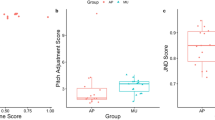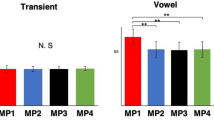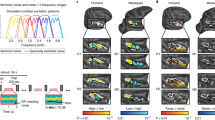Abstract
'Pitch' refers to a sound's subjective highness or lowness, as distinct from 'frequency,' which refers to a sound's physical structure. In speech, music and other natural contexts, complex tones are often perceived with a single pitch. Using whole-head magnetoencephalography (MEG) and stimuli that dissociate pitch from frequency, we studied cortical dynamics in normal individuals who extracted different pitches from the same tone complexes. Whereas all subjects showed similar spatial distributions in the magnitude of their brain responses to the stimuli, subjects who heard different pitches exhibited contrasting temporal patterns of brain activity in their right but not their left hemispheres. These data demonstrate a specific relationship between pitch perception and the timing (phase) of dynamic patterns of cortical activity.
This is a preview of subscription content, access via your institution
Access options
Subscribe to this journal
Receive 12 print issues and online access
$209.00 per year
only $17.42 per issue
Buy this article
- Purchase on Springer Link
- Instant access to full article PDF
Prices may be subject to local taxes which are calculated during checkout






Similar content being viewed by others
References
Licklider, J. C. R. A duplex theory of pitch perception. Experientia 7, 128–134 (1951).
Terhardt, E. Pitch, consonance, and harmony. J. Acoust. Soc. Am. 55, 1061–1069 (1974).
Shamma, S. & Klein, D. The case of the missing pitch templates: how harmonic templates emerge in the early auditory system. J. Acoust. Soc. Am. 107, 2631–2644 (2000).
Greenberg, S., Marsh, J. T., Brown, W. S. & Smith, J. C. Neural temporal coding of low pitch. I. Human frequency following responses to complex tones. Hearing Res. 25, 91–114 (1987).
Goldstein, J. An optimum processor theory for the central formation of pitch of complex tones. J. Acoust. Soc. Am. 54, 1496–1516 (1973).
Cohen, M., Grossberg, S. & Wyse, L. A spectral network model of pitch perception. J. Acoust. Soc. Am. 98, 862–879 (1995).
Meddis, R. & Hewitt, J. Virtual pitch and phase sensitivity of a computer model of the auditory periphery I: pitch identification. J. Acoust. Soc. Am. 89, 2866–2882 (1991).
Cariani, P. A. & Delgutte, B. Neural correlates of the pitch of complex tones. I. Pitch and pitch salience. J. Neurophysiol. 76, 1698–1716 (1996).
Lyon, R. & Shamma, S. in Auditory Computation (eds. Hawkins, H. L., McMullen, T. A., Popper, A. N. & Fay, R. R.) 221–270 (Springer, New York, 1996).
Galambos, R., Makeig, S. & Talmachoff, P. J. A 40-Hz auditory potential recorded from the human scalp. Proc. Natl. Acad. Sci. USA 78, 2463–2647 (1981).
Hari, R., Hämäläinen, M. & Joutsiniemi, S.-L. Neuromagnetic steady-state responses to auditory stimuli. J. Acoust. Soc. Am. 86, 1033–1039 (1989).
Ross, B., Borgmann, C., Draganova, R., Roberts, L. & Pantev, C. A high-precision magnetoencephalographic study of human auditory steady-state responses to amplitude-modulated tones. J. Acoust. Soc. Am. 108, 679–691 (2000).
Pantev, C., Roberts, L. E., Elbert, T., Ross, B. & Wienbruch, C. Tonotopic organization of the sources of human auditory steady-state responses. Hearing Res. 101, 62–74 (1996).
Gutschalk, A. et al. Deconvolution of 40 Hz steady-state fields reveals two overlapping source activities of the human auditory cortex. Clin. Neurophysiol. 110, 856–868 (1999).
Patel, A. D. & Balaban, E. Temporal patterns of human cortical activity reflect tone sequence structure. Nature 404, 80–84 (2000).
John, M. S. & Picton, T. W. Human auditory steady-state responses to amplitude-modulated tones: phase and latency measurements. Hearing Res. 141, 57–79 (2000).
Langner, G. & Schreiner, C. Periodicity coding in the inferior colliculus of the cat. J. Neurophysiol. 60, 1805–1822 (1988).
Greenberg, S., Poeppel, D. & Roberts, T. in Psychophysical and Physiological Advances in Hearing (eds. Palmer, A., Summerfield, Q., Rees, A. & Meddis, R.) 293–300 (Whurr, London, 1998).
Makeig, S., Jung, T-P., Bell, A. J., Ghahremani, D. & Sejnowski, T. J. Blind separation of auditory event-related brain responses into independent components. Proc. Natl. Acad. Sci. USA 94, 10979–10984 (1997).
Sokal, R. R. & Rohlf, F. J. Biometry 3rd edn. (W. H. Freeman, New York, 1995).
Pantev, C., Elbert, T., Ross, B., Eulitz, C. & Terhardt, E. Binaural fusion and the representation of virtual pitch in the human auditory cortex. Hearing Res. 100, 164–170 (1996).
Langner, G., Sams, M., Heil, P. & Schulze, H. Frequency and periodicity are represented in orthogonal maps in the human auditory cortex: evidence from magnetoencephalography. J. Comp. Physiol. A 181, 655–676 (1997).
Griffiths, T. D., Büchel, C., Frackowiak, S. J. & Patterson, R. D. Analysis of temporal structure in sound by the human brain. Nat. Neurosci. 1, 422–427 (1998).
Zatorre, R. Pitch perception of complex tones and human temporal lobe function. J. Acoust. Soc. Am. 84, 566–572 (1988).
Johnsrude, I. S., Penhune, V. B. & Zatorre, R. Functional specificity in the right human auditory cortex for perceiving pitch direction. Brain 123, 155–163 (2000).
Scott, S. K., Blank, C. C., Rosen, S. & Wise, R. J. S. Identification of a pathway for intelligible speech in the left temporal lobe. Brain 123, 2400–2406 (2000).
Wetzel, W., Ohl, F. W., Wagner, T. & Scheich, H. Right auditory cortex lesion in Mongolian gerbils impairs discrimination of rising and falling frequency-modulated tones. Neurosci. Lett. 252, 115–118 (1998).
Tallal, P., Merzenich, M. M., Miller, S. & Jenkins, W. Language learning impairments: integrating basic science, technology, and remediation. Exp. Brain Res. 123, 210–219 (1998).
Galbraith, G. C. Two-channel brain-stem frequency-following responses to pure tone and missing fundamental stimuli. Electroencephalogr. Clin. Neurophysiol. 92, 321–330 (1994).
Griffiths, T. D., Uppenkamp, S., Johnsrude, I., Josephs, O. & Patterson, R. D. Encoding of the temporal regularity of sound in the human brainstem. Nat. Neurosci. 4, 633–637 (2001).
Siegel, S. & Castellan, N. J. Jr. Nonparametric Statistics for the Behavioral Sciences (McGraw Hill, New York, 1988).
Acknowledgements
We thank L. Kurelowech for technical assistance and Y. Chen for comments. This research was supported by Neurosciences Research Foundation as part of its research program on Music and the Brain at The Neurosciences Institute.
Author information
Authors and Affiliations
Corresponding authors
Supplementary information
Rights and permissions
About this article
Cite this article
Patel, A., Balaban, E. Human pitch perception is reflected in the timing of stimulus-related cortical activity. Nat Neurosci 4, 839–844 (2001). https://doi.org/10.1038/90557
Received:
Accepted:
Issue Date:
DOI: https://doi.org/10.1038/90557
This article is cited by
-
In-ear integrated sensor array for the continuous monitoring of brain activity and of lactate in sweat
Nature Biomedical Engineering (2023)
-
Characteristics of auditory steady-state responses to different click frequencies in awake intact macaques
BMC Neuroscience (2022)
-
Hierarchical Neural Encoding of Temporal Regularity in the Human Auditory Cortex
Brain Topography (2015)
-
Spatiotemporal characteristics of the neural activities processing consonant/dissonant tones in melody
Experimental Brain Research (2005)
-
Morphology of Heschl's gyrus reflects enhanced activation in the auditory cortex of musicians
Nature Neuroscience (2002)



